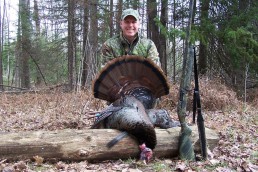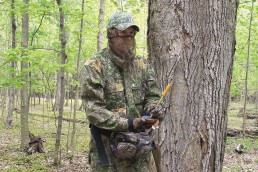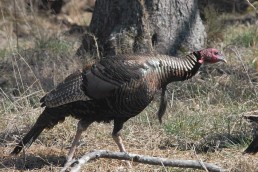Five Mistakes to Avoid when Calling a Turkey
SHARE THIS POST
Owning all of the turkey calls in the world is no guarantee that a turkey will buy the gig and come walking in. You have to pull out your bag of tricks if you want to walk out of the woods with a gobbler draped over your shoulder. Darin Potter shares his five mistakes to avoid when calling a turkey.
I have to admit––I am addicted to buying turkey calls. This is no secret among my family and friends who are use to me going nuts every time we enter a sporting goods store. If you happen to see me, chances are you will find me drooling in the hunting department amongst the wide assortment of turkey calls. My addiction doesn’t end there, either. I’m constantly using my laptop or phone to gaze at them as well. Do I have a problem? Well, I guess they say the first step is to admit in having one, so yes, I do.
As I write this, it’s the middle of winter; however, thoughts of turkey hunting quickly replace the winter doldrums, and soon I find myself thinking about turkey calls. With that said, it’s never too early to pick one up and start practicing for the spring season, which is just over the horizon.
Whether it is a box, slate or push-pull call, there is something about them that fascinates me. Maybe it is their design, craftsmanship, style, allure or their sole purpose: to call in a thunder chicken within shooting range. The beauty of it is, you can never own too many turkey calls. However, having a wide variety of calls in your turkey hunting arsenal is just one small ingredient to filling your spring tag.
Owning all of the turkey calls in the world is no guarantee that a longbeard will buy the gig and come waltzing in. You have to pull out your bag of tricks if you want to walk out of the turkey woods with a gobbler draped over your shoulder. On the turkeys’ turf, there is a variety of different factors that need to be taken into consideration. Unfortunately, the following mistakes have left many turkey hunters scratching their heads and heading home empty-handed. Here are five mistakes to avoid when calling a turkey.
Complacency
Using only one call, not switching calls, sticking with the same one season after season, you get my point. Being complacent with your old stand-by call can be detrimental if you want to be successful in the turkey woods. If hunting pressure is high in the area you’re hunting, a wise old turkey will run in the other direction if you keep throwing the same sound at him. Switch it up! This is where my addiction isn’t all that bad. Owning numerous turkey calls gives you the ability to sound like more than one hen.
A couple of years ago, my wife and I were setup in a tent blind along the edge of a field when two toms approached us. I did my best to imitate a hen on my slate call, but they ignored me and kept walking on by. I quickly switched to a glass call, which caused them to turn 180 degrees and come to within shooting range, allowing my wife to take her first turkey.
Not maintaining your calls
There is nothing that annoys me more than a screeching turkey call because the chalk wore off or it hasn’t been sanded in awhile. However, this can be easily avoided with a few simple steps. In order for the sound of your calls to remain crisp and sharp, you need to maintain them throughout turkey season so that they are ready to use during each hunt. This only takes a few minutes and is well worth your time.
To prevent this from happening, apply chalk to the striking surface of your box and push-pull calls. Also, rub your slate and peg calls with either fine-grit drywall paper or a small Scotch-Brite pad for glass or slate calls, respectively. When hunting, you should inspect your calls periodically for any signs of wear. For maintenance on your diaphragm calls, simply clean them off using mouthwash and then store them in a small, clean case. This will allow them to be easily accessible for use.
Are you enjoying this post?
You can be among the first to get the latest info on where to go, what to use and how to use it!
Calling too loudly at close range
A lot of hunters think that they need to call really loud to grab the attention of a gobbler; however, when you set up first thing in the morning, it’s better to call softly just in case the birds are roosting nearby. Once you find out that they’re farther away, then you can start increasing the volume of your calling.
Once a gobbler reaches that magical 70-yard mark or so, you need to really tone down your volume. Turkeys will seldom call very loudly unless they are a long distance away from other birds and attempting to locate each other. However, based on my observations once they are close, turkeys usually make only subtle purrs, clucks and yelps. Therefore, when you set up near a field or opening and a gobbler is in view, let out a few soft yelps and see what his reaction is. If you’re using decoys and he continues to waltz in closer, stop calling and let him close the distance at his own will.
Calling softly when a gobbler is hung-up with some hens is a great tactic that will occasionally help pull him away from his harem. This fools the tom into believing that the so-called hen is moving in the opposite direction.
Not practicing ahead of time
Most turkey hunters will wait until the night before the turkey opener to get all of their turkey calls out and start practicing. However, if you want to sound as close to a real hen as possible, you need to spend some time during the off-season improving your turkey calling skills. This is how you convince a gobbler that you’re the real thing. As I mentioned above, winter is an excellent time to start practicing. However, this may drive your significant other crazy, but it’s worth it.
By no means must you be a turkey contest caller to get the job done, either. If your rhythm and pitch are close to how a real turkey sounds, then you should have no problem being successful in the turkey woods.
There are numerous sources that will help you improve your calling. Last year I found a page dedicated to calling on the National Wild Turkey Federation’s website. On the page was a written explanation of what the call consists of, when the bird uses this call, and what situations to use it. There is also a tab where you can play each individual turkey sound. Some of these included a cluck, purr, tree call, fly-down cackle, assembly call, yelp, cut and gobble. Other excellent sources include turkey hunting DVDs, turkey calling seminars and calling contests.
Calling for too long
A gobbler was hot off the roost and now the woods have gone silent. If this occurs, you need to ask yourself two things. Is the bird henned up, or is he on his way? Continuing to call to a gobbler that is uninterested doesn’t do you any good. You’re better off hitting the road and trying your luck elsewhere. However, there is a fine line on the waiting period.
One spring morning it was clear that a longbeard, didn’t buy in to my best attempt to sound like a hen. About two hours had passed, and the gobbler finally decided to make an appearance into the field before us. Sometimes you need to roll the dice and give him either more time, or run and gun.
Watch our Spring Turkey Hunt in the Rain video.
Become a MidWest Outdoors Insider here!
MWO
SHARE THIS POST
Did you enjoy this post?
You can be among the first to get the latest info on where to go, what to use and how to use it!
Darin Potter
Darin Potter’s passion for outdoor writing began at the age of 12 when he first began writing in a journal that his parents bought him on a family camping trip in Northern Michigan. His writings have appeared in several Midwest publications: Michigan-Out-of-Doors, Michigan and Ohio Outdoor News, Modern Pioneer, and MidWest Outdoors.



